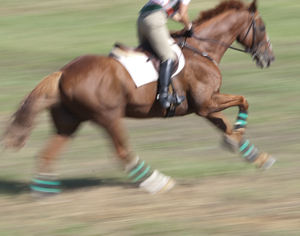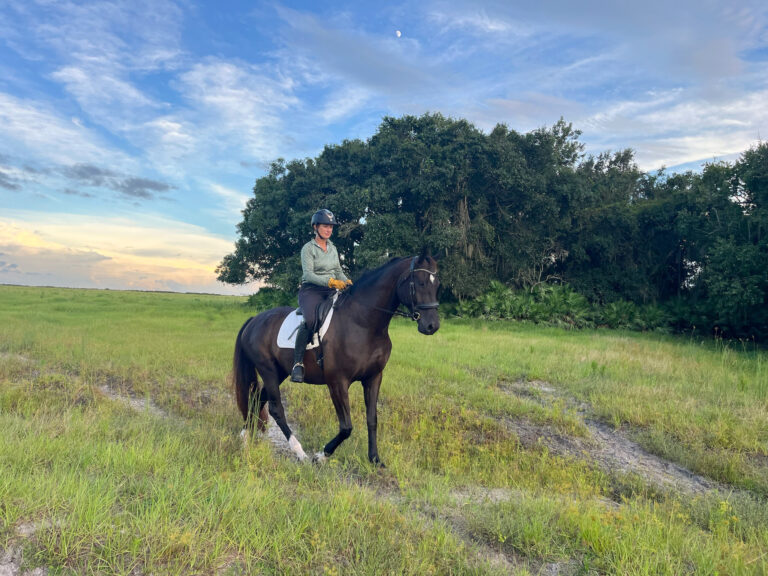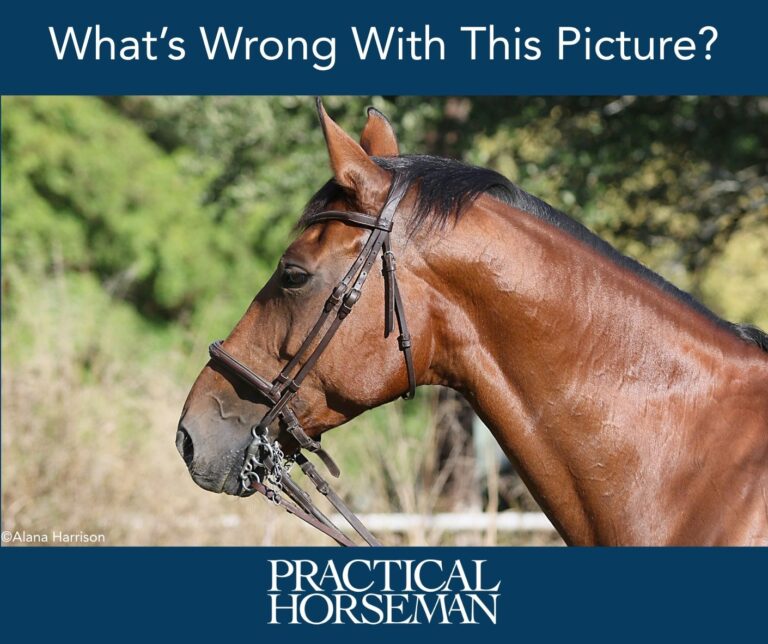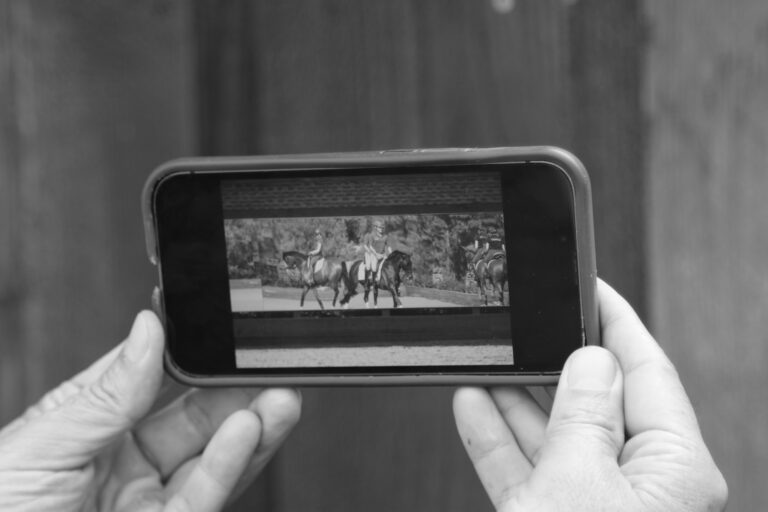How is a sporthorse like an NBA basketball star? Injuries—anything from bumps and bruises to torn tendons and damaged joints—can put him on the sidelines. While any horse can get hurt, the demands of eventing, dressage and hunter/jumper competition increase the risk of suspensory ligament injuries, deep digital flexor tendon tears, sore muscles and more.

This article explains how five common types of sporthorse injuries happen, how they’re treated and how they may affect your horse’s career. These injuries occur across the disciplines, but some types are more common in certain sports.
- Jumping, speed, uneven ground and fatigue put eventers and jumpers at greater risk for injuries that are sudden and severe. Your horse lands awkwardly from a jump or sets his foot down badly on rough ground, and the result is a torn tendon or ligament.
- Dressage horses may be less prone to “bad-step” injuries, but repetitive stress is a big factor for them. They’re prone to muscle soreness, microscopic tears in ligaments and joint problems—injuries that can become chronic and limit what the horse can do.
Bringing your horse back from any injury can be frustrating. The damage may be hard to diagnose, and there are no cookbook formulas for recovery because no two injuries are exactly the same. Ideally, you’ll keep your horse off the injured list.
Suspensory Ligament Injuries
The suspensory ligament runs down the back of the cannon bone from just below the knee (or hock), splitting into two branches that pass around the back of the ankle and end on the front of the long pastern bone below. Its job is to support the ankle joint as it sinks under weight and returns to normal when the weight comes off.
If your horse overloads the leg, the suspensory may give way. The injury may be mild, a few of the ligament’s tough collagen fibers tear but repeated stress will make it worse. In a severe injury, the ligament may rupture or even fracture bone as it tears away.
Most at risk: Acute front suspensory tears are a particular danger for eventers and jumpers because speed and jumping increase the load on the forelimbs and the chances of a misstep. Hind suspensory injuries may be more common in dressage horses because these horses work more off their hind ends. Many are also heavy, which puts added strain on the ligament. Risk for all horses increases with work level and intensity, poor footing and lack of fitness.
Signs: Suspensory injuries can be tricky to spot. Lameness ranges from severe to barely noticeable, depending on how bad the damage is. If the tear is in the main body or the branches, the leg may be warm, swollen and sensitive at the site. But the top of the ligament is hidden by other structures, so you may not see those signs if the tear is high.
Local nerve blocks and a hands-on exam will help your veterinarian find the problem. An ultrasound scan may help pinpoint the exact location and reveal the extent of damage to the ligament, and X-rays will show if bone is involved.
Action: Your veterinarian will help you work out a treatment plan that suits your horse’s specific injury. Treatment usually includes these steps:
- Cool down. Your vet may prescribe cold therapy (icing or cold-hosing several times a day) and a nonsteroidal anti-inflammatory drug, such as phenylbutazone or Banamine (flunixin meglumine), to reduce inflammation.
- Stall rest to give the ligament time to heal. Your vet may advise standing wraps for the injured leg and the opposing leg.
- Hand-walking, to encourage healing. Follow your vet’s advice, starting with as little as 10 minutes a day and gradually increasing the time.
- Gradual return to exercise. With your vet, set up a program that eases your horse back into work over several months, using ultrasound exams to monitor the ligament and adjust the program as needed.
Depending on the case, your vet may suggest other therapies like shockwave treatment; new regenerative therapies, such as stem cells and platelet-rich plasma; or surgery.
How long will all this take? Ligaments heal slowly. A mild strain may take six to eight weeks, but a tear can take eight to 12 months. High hind suspensory injuries can be especially frustrating because your horse’s anatomy makes it hard to follow healing there and harder to know when your horse is ready to return to work. Keep in mind that he may trot sound long before the ligament is healed, and rushing his rehab is likely to cause a setback.
Outlook: Ligaments tend to heal poorly, with fibrous scar tissue that’s prone to reinjury. While many horses make full recoveries, chronic suspensory problems require careful management. This can be a limiting factor for your horse, and it’s hard to judge where the limit is. Even a sensitive rider won’t pick up on the moment when her horse feels the first twinge of pain.
DDFT Damage
The deep digital flexor tendon runs down the back of the leg and behind the heel to attach to the bottom of the coffin bone (the bone that underlies the hoof wall at the front). Its main job is to flex the leg, but it also plays a support role at the heel, where the tendon fibers fan out to pass over the navicular bone.
Injuries in the lower section of this tendon, from midpastern into the foot, are common for sporthorses. The tendon stretches taut when your horse weights his foot and at the moment of breakover, when his weight passes over the toe and the heel begins to lift. If the stress is too great, fibers may tear or pull away from the coffin bone. This section of the tendon may also become chronically inflamed and thickened from repeated stress, a condition called tendinitis.
Most at risk: Jumping and work at speed can overload the tendon because the DDFT stretches to the max as your horse pushes off at the gallop or after landing from a jump. Mechanics of conformation or poor shoeing may contribute—a horse who has long toes and low heels puts extra stress on the lower part of this tendon during breakover.
Signs: Lameness varies. Sometimes there’s heat, swelling and sensitivity at the back of the pastern or above the heel, but you may not see these signs if the injury is down in the foot.
Tendon injuries can be hard to pinpoint in the foot. Local nerve blocks will tell your vet that your horse is sore in his heel but not whether the problem is the tendon, the navicular bone or some other structure. Ultrasound scans will reveal tendon damage higher up but are not so helpful within the hoof capsule. Magnetic resonance imaging, available at some major clinics, shows these injuries well.
Action: Tendons are a lot like ligaments and heal in the same way—that is, slowly.
- Follow the steps outlined in the suspensory section: cool down, rest, hand-walking and a gradual return to work, based on the program your veterinarian sets out.
- Shoeing changes (such as rolled or rockered toes to ease breakover) may be part of the program.
- If the problem is tendinitis, your veterinarian may suggest an injection of anti-inflammatory medications into the tendon sheath (covering).
Regenerative therapies, such as stem cells and platelet-rich plasma, are being used to improve healing in torn tendons and ligaments alike. These treatments theoretically help the tissues heal stronger, but they don’t shorten the layup and rehab time.
Outlook: DDFT injuries can sideline horses for varying amounts of time. If your horse has a very mild strain, he may be back in work in six to eight weeks. For a tear, think months—it’s not uncommon for horses to be laid up eight months or more. Doing too much, too soon, is a recipe for reinjury.
A healed tendon, like a healed ligament, is never quite as strong as it was before the injury. The question is always: Will it hold up? The answer depends on how severe your horse’s injury was to begin with, how well it healed and what your expectations are for his future performance.
Bone Bruise
Sporthorses can bruise bones in the foot and ankle joints—the coffin bone, the ends of the short and long pastern bones and the lower end of the cannon bone. The foot and ankle come under tremendous force, and that force is focused on the small areas where these bones meet.
Although a bone bruise isn’t as serious as a fracture, there is microscopic damage to the bone. And as with any bruise, there’s internal bleeding and swelling; but in this case the fluid builds up within the bone.
Most at risk: Bruising is caused by impact landing off a jump or working on hard ground?so jumpers and eventers are most at risk.
Signs: Bone bruises are painful, so your horse will be sore. Your vet can isolate the sore zone with nerve blocks, but it may take sophisticated imaging techniques to identify the cause. X-rays won’t show the microscopic bone damage, but a bruise may show up as a “hot spot” on a nuclear bone scan. MRI is a good diagnostic technology to delineate the bruise.
Action: Your horse will need time off, perhaps three or four months, depending on the degree of bruising. He may benefit from an extended course of anti-inflammatory medication. An NSAID such as Equioxx (firocoxib), which belongs to a class of drugs called cox-2 inhibitors, may be a good choice. These drugs tend to have fewer side effects than other NSAIDs when given for extended periods.
Outlook: Injured bones heal slowly, but they’re typically good as new once healing is done. Good shoeing (sometimes with pads) and good footing can help prevent reinjury as your horse starts back into regular work.
Inflamed Joints
Acute synovitis is inflammation that appears suddenly in a joint, often the ankle, coffin or hock. These joints are enclosed in a capsule of soft tissue; the capsule lining (synovial membrane) produces a thick fluid that lubricates the joint. Stress on the joint can trigger inflammation in the lining and the capsule, causing fluid to turn watery and build up. Over time, repeated joint stress can set off a destructive chain of events that lead to osteoarthritis.
Most at risk: Inflamed joints occur across the board, typically when there’s a sudden change in work level or intensity—a dressage horse is asked to move up a level too quickly, say, or a hunter does more at a show than he’s used to. Actions such as jumping, work at collected gaits, tight turns and small circles are especially hard on the joints. Unfamiliar footing is another risk factor.
Signs: Your horse will be sore or stiff, especially at the start of work. In a mild case he may just seem less fluid or less forward in his gaits. You may find heat, pain and swelling caused by the inflammation in the joint.
Your veterinarian can identify the problem with a physical exam. X-rays can rule out damage to the bones and cartilage, and synovial fluid can be collected and analyzed to rule out infection.
Action: Reducing the inflammation will ease the pain and risk of joint degeneration.
- Give him some time off. Depending on the case, this may be stall rest, hand-walking or controlled turnout in a small paddock, for as little as seven to 10 days to as long as a month.
- Cold therapy can help in the early stages when there’s heat in the joint. Your vet may prescribe a short course of anti-inflammatory medication. Topical treatments—poultices, DMSO or Surpass (diclofenac sodium) may help reduce inflammation.
- Joint injections can help horses with severe or recurrent synovitis. The injections deliver anti-inflammatory agents,usually a corticosteroid alone or in combination with hyaluronic acid, which is a natural component of cartilage and joint fluid directly into the joint.
IRAP therapy is a new approach in which the joint is injected with interleukin-1 receptor antagonist protein, a substance derived from the horse’s own blood. It targets a specific inflammatory pathway involved in joint degeneration.
Outlook: Most horses with acute synovitis respond well to rest and steps to reduce inflammation. It’s important to prevent repeat episodes that could lead to osteoarthritis, so increase your horse’s work level gradually, be sure he’s in shape for what you ask and space out demanding work sessions and shows to give him time to recover.
Sore Muscles
Work strengthens muscles, but overwork leads to strain and pain. The large muscles of the back and hindquarters make up a sporthorse’s drive train, and they can be strained if they’re asked to work too hard for too long. Most muscle strains are mild, and the amount of damage is small but this is a common injury, and it can be enough to keep your horse from performing his best.
Most at risk: Dressage horses who are asked to collect and maintain a frame as they work often become sore in the back, hindquarters and gaskins. Heavy muscling and general heaviness seem to add to the problem. Hunters and jumpers may develop similar problems if they’re forced into draw reins or longed in a training rig for long periods; the horse has no chance to stretch and relax his back and neck, so the muscles get sore.
Signs: Signs of back pain can be mild and frustratingly vague. Your horse may move off stiffly when you mount and he feels your weight on his back. His hind legs may not really step up under his body, so he doesn’t really carry himself. He may resist bending, rounding and collecting. His ears and the way he carries his head tell you that he’s tense and worried. Most of these signs may improve as he warms up.
Action: Give your horse a few days off to see if the mild signs disappear. If they don’t, or if they recur when he goes back to work, ask your veterinarian to check him. Any underlying causes will have to be addressed for his back to improve:
- The pain may stem from a poorly fitting saddle.
- It may be below the muscles, perhaps in the sacroiliac joint, the meeting place of the pelvis and the spine. (Jumping, galloping and tight turns and circles put a lot of stress on this joint.)
- It may originate someplace else entirely. A horse with hock problems may develop sore back muscles if those muscles work overtime in an effort to spare the hocks.
When the problem is simple muscle strain, most horses get better with rest and turnout. Your veterinarian can help determine how much rest and what type of exercise is best for your horse.
- Some horses improve with a short course of muscle relaxants or with acupuncture or chiropractic treatments.
- Massage also can help.
Don’t overlook the benefits of a thorough currying, which is a massage in itself.
Outlook: Good management helps most sore backs. Give your horse a chance to warm up before you ask him to do collected work. Let him stretch his back and neck muscles by riding “long and low” (on a long rein) or walking up and down hills. Vary his work—ring work one day, a hack in the field the next—and avoid repeating the same maneuvers over and over. And give him plenty of turnout time, which will help keep his back limber.
An FEI-certified veterinarian, Duncan Peters, DVM, MS, heads the Sporthorse Program at Hagyard Equine Medical Center in Lexington, Kentucky.
This article originally appeared in the October 2011 issue of Practical Horseman.








